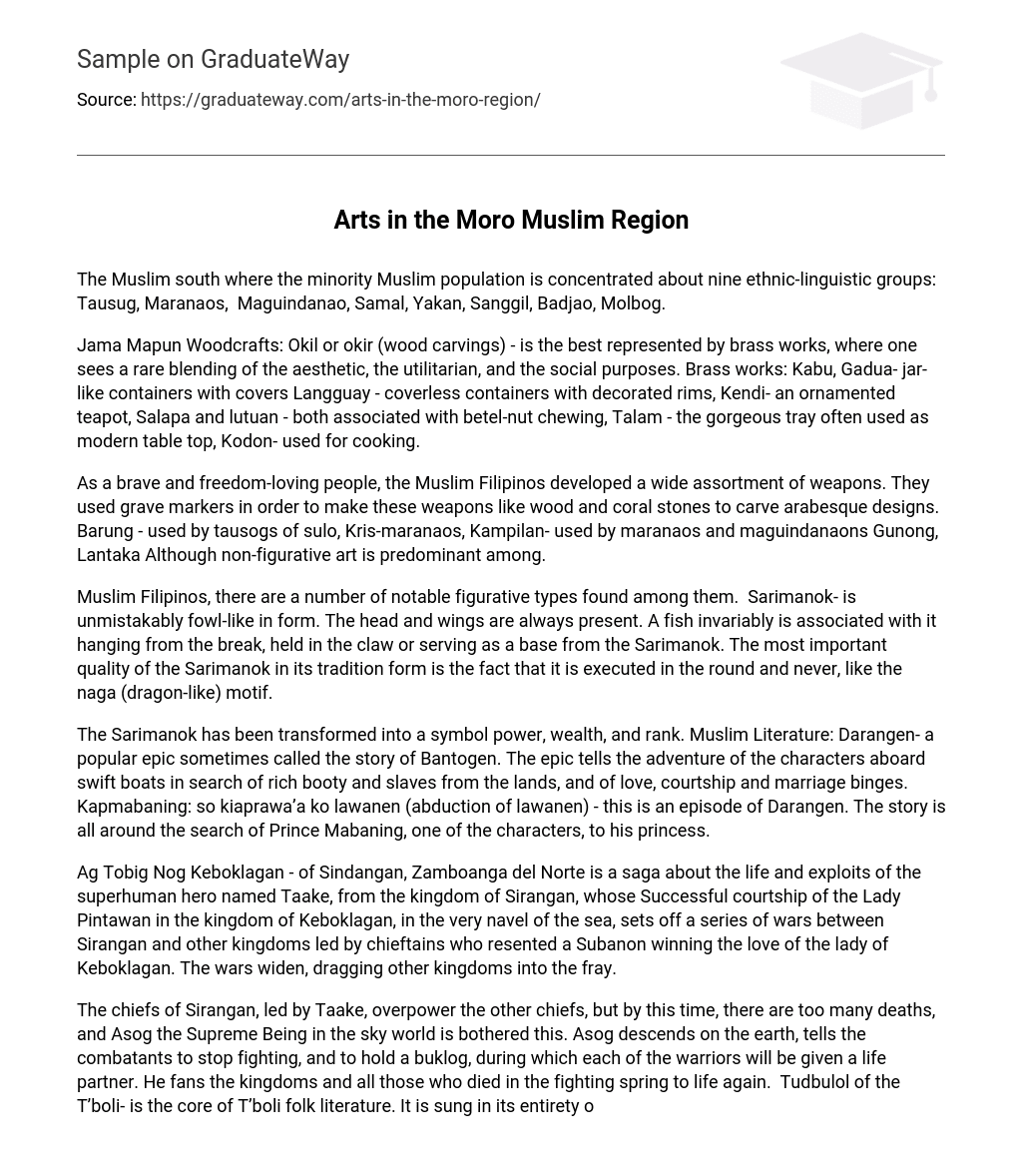The Muslim south, where the minority Muslim population is concentrated, is made up of about nine ethnic-linguistic groups: Tausug, Maranaos, Maguindanao, Samal, Yakan, Sanggil, Badjao, and Molbog.
Jama Mapun Woodcrafts produces Okil or okir (wood carvings) that are best represented by brass works, where one sees a rare blending of the aesthetic, the utilitarian, and the social purposes. Brassworks include Kabu and Gadua, jar-like containers with covers, Langguay, coverless containers with decorated rims, Kendi, an ornamented teapot, Salapa, and lutuan, both associated with betel-nut chewing, Talam, the gorgeous tray often used as a modern tabletop, and Kodon, used for cooking.
As a brave and freedom-loving people, the Muslim Filipinos developed a wide assortment of weapons. They used materials like wood and coral stones to carve Arabesque designs to make these weapons. Weapons include Barung, used by Tausogs of Sulo, Kris-Maranaos, and Kampilan, used by Maranaos and Maguindanaons, Gunong, and Lantaka. Although non-figurative art is predominant among Muslim Filipinos, many notable figurative types are found among them. Sarimanok is unmistakably fowl-like in form. The head and wings are always present. A fish invariably is associated with it hanging from the break, held in the claw, or serving as a base for the Sarimanok. The most important quality of the Sarimanok in its traditional form is the fact that it is executed in the round and never like the naga (dragon-like) motif.
The Sarimanok has been transformed into a symbol of power, wealth, and rank. Muslim Literature includes Darangen, a popular epic sometimes called the story of Bantogen. The epic tells the adventures of the characters aboard swift boats in search of rich booty and slaves from the lands and of love, courtship, and marriage binges. Kapmabaning: so kiaprawa’a ko lawanen (abduction of lawanen) – this is an episode of Darangen. The story revolves around the search of Prince Mabaning, one of the characters, for his princess.
Ag Tobig Nog Keboklagan – of Sindangan, Zamboanga del Norte, is a saga about the life and exploits of the superhuman hero named Taake, from the kingdom of Sirangan, whose successful courtship of the Lady Pintawan in the kingdom of Keboklagan, in the very navel of the sea, sets off a series of wars between Sirangan and other kingdoms led by chieftains who resented a Subanon winning the love of the lady of Keboklagan. The wars widen, dragging other kingdoms into the fray.
The chiefs of Sirangan, led by Taake, overpower the other chiefs, but by this time, there are too many deaths, and Asog, the Supreme Being in the sky world, is bothered by this. Asog descends on the earth, tells the combatants to stop fighting, and to hold a buklog, during which each of the warriors will be given a life partner. He fans the kingdoms and all those who died in the fighting spring to life again. Tudbulol of the T’boli is the core of T’boli folk literature. It is sung in its entirety only on important occasions.
Singing of the epic may take up to 16 hours, depending on the version sung, and is usually done through the night. “O Papanok” and “Bangsamoro” are Moro songs. “Parang Sibil” (Sword of Honor) is Kinding Sindaw’s newest dance and music drama, depicting the conquest of the Tausug people by the Americans, a historical event of the previous century now largely forgotten in Philippine and American histories. The story is immortalized in the “Parang Sabil” ballad of the Tausug people.
Kinding Sindaw’s adaptation intertwines Tausug dance, music, and storytelling with commentary by American writer and journalist Mark Twain, who was morally outraged by the United States’ brutal subjugation of the Philippines. The musical instruments used include Muslim string instruments such as Serogaganding, which is a two-stringed zither, and Kudyapi, the most popular stringed instrument among Maranaos and Maguindanaons, which has two metal strings raised on small bridges.
Below are some of the Muslim percussion instruments: Gamelan, which is an ensemble of a variety of gongs; Agunay, a gong with a boss made of brass, which may be alone or found in a set suspended from a frame in rows and gives off a thick muffled sound; Babandir, usually made of bronze, wide-rimmed, big-bossed; because of the fineness of the bronze of which it is made, its sounds are very resonant but low when beaten; Gandingan, which has a low, thick sound, is usually made of brass and is often big but narrow ridged; Kulintang, which is a row of 7 or 8 gradually pitched gongs set horizontally on a designed wooden framework; Gabbong, a Sulo and Yakan version of the xylophone, a series of bamboo slate nailed on wood and played by striking the slate with a rubber-covered hammer; and Dabakan, a singled-headed drum primarily used as a supportive instrument in the kulintang ensemble.





